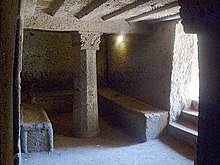|
Cerveteri
Cerveteri (Italian: [tʃerˈvɛːteri]) is a comune (municipality) in the Metropolitan City of Rome Capital, in the Italian region of Lazio. Known by the ancient Romans as Caere, and previously by the Etruscans as Caisra or Cisra, and as Agylla (or Άγυλλα) by the Greeks, its modern name derives from Caere Vetus used in the 13th century to distinguish it from Caere Novum (the current town). It is the site of the ancient Etruscan city[3] which was one of the most important Etruscan cities with an area more than 15 times larger than today's town. The best known structures on the site form the Banditaccia Necropolis. Caere was one of the city-states of the Etruscan League and at its height, around 600 BC, its population was perhaps around 25,000 – 40,000 people.[4][5][6][7][8] SiteThe ancient city was situated about 7 km (4.3 mi) from the sea, a location which made it a wealthy trading town derived originally from the iron-ore mines in the Tolfa Hills.[9] It had three sea ports including Pyrgi, connected to Caere by a road about 13 km (8.1 mi) long and 10 m (33 ft) wide, and Punicum. Pyrgi was also known for its sanctuary of monumental temples from 510 BC, built by the king of Caere and dedicated to the goddesses Leucothea and Ilithyia, of which several sculptures are exhibited at the Villa Giulia. HistoryMonuments    Little is known of the ancient city, although six temples are known from various sources. Two of them have been excavated, one of Hera, the other in the north of the city. Parts of the city walls are still visible today and excavations opened up a theatre. Three necropolis were found. The contents of the tombs were excavated, often chaotically and illegally; over the last few centuries, they have yielded rich and exquisite objects, including ceramics and jewellery which today grace many of the world's museums. One famous and important work of art is the Sarcophagus of the Spouses. Necropolis of the BanditacciaThe most famous attraction of Cerveteri is the Etruscan Necropoli della Banditaccia, which has been declared by UNESCO as a World Heritage Site together with the necropolis in Tarquinia. It covers an area of 400 hectares (990 acres), of which 10 hectares (25 acres) can be visited, encompassing a total of about 1,000 tombs often housed in characteristic mounds. It is the largest ancient necropolis in the Mediterranean area. The name Banditaccia comes from the leasing (bando) of areas of land to the Cerveteri population by the local landowners. The tombs date from the 9th century BC (Villanovan culture) to the later Etruscan period (third century BC). The earliest tombs are in the shape of a pit, in which the ashes of the dead were housed; also, simple potholes are present. The most important tombs include:
From the later Etruscan period are two types of tombs: tumulus-type tombs and the so-called "dice", the latter being simple square tombs built in long rows along roads within the necropolis. The visitable area contains two such roads, the Via dei Monti Ceriti and the Via dei Monti della Tolfa (6th century BC). The tumuli are circular structures built in tuff, and the interiors, carved from the living rock, house a reconstruction of the house of the dead, including a corridor (dromos), a central hall, and several rooms. Modern knowledge of Etruscan daily life is largely dependent on the numerous decorative details and finds from such tombs. One of the most famous tombs is the Tomb of the Reliefs, identified from an inscription as belonging to the Matuna family and provided with an exceptional series of frescoes, bas-reliefs and sculptures portraying a large series of contemporary life tools.[10][11] The most recent tombs date from the 3rd century BC. Some of them are marked by external cippi, which are cylindrical for men, and in the shape of a small house for women. A large number of finds excavated at Cerveteri are in the National Etruscan Museum, Rome, with others in the Vatican Museums and many other museums around the world. Others, mainly pottery, are in the Archaeological Museum at Cerveteri itself. Other monuments
Cerveteri DOCAround the city of Cerveteri is an Italian DOC wine region that produces red and white blended wines. The red wines are blends of 60% Sangiovese and Montepulciano, 25% Cesanese and up to 30% of Canaiolo, Carignan and Barbera. The grapes are limited to a harvest yield of 15 tonnes/ha and the final wine must have a minimum alcohol level of 11%. The white wines are composed of a minimum blend of 50% Trebbiano Romagnolo and Giallo, a maximum of 35% Malvasia di Candia and a maximum of 15% Friulano, Verdicchio, Bellone and Bombino bianco. The grapes are limited to a harvest yield of 14 tonnes/ha and the final wine must have a minimum alcohol level of 12%.[12] Ancient bishopricFor the ancient bishopric that originally had its seat in Cerveteri and is now a titular see (see Caere). Twin cities
References
Further reading
External links
|
||||||||||||||||||||||||||||||||||||||||||||||||||||||||||||



